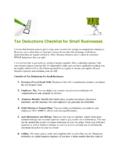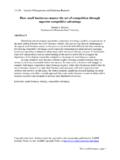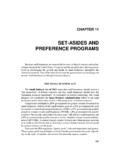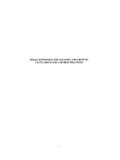Transcription of 401(k) Plans for Small Businesses
1 401(k) Plans for Small Businesses is a joint project of the Department of Labor s Employee Benefits Security Administration (DOL/EBSA) and the Internal Revenue Service. To view this and other EBSA publications, visit the agency s website at: order publications or to request assistance from a benefits advisor, contact EBSA electronically at: call toll free: publication will be made available in alternative format to persons with disabilities upon request:Voice phone: 202-693-8664 TDD: 202-501-3911 This publication constitutes a Small entity compliance guide for purposes of the Small Business Regulatory Enforcement Fairness Act of publication does not constitute legal, accounting, or other professional 401(k) Plans ? 401(k) Plans can be a powerful tool in pro-moting financial security in retirement. They are a valuable option for Businesses consid-ering a retirement plan, providing benefits to employees and their employers.
2 Employers start a 401(k) plan for many reasons: q A well-designed 401(k) plan can help attract and keep talented employees. q It allows participants to decide how much to contribute to their Employers are entitled to a tax deduction for contributions to employees A 401(k) plan benefits a mix of rank-and- file employees and The money contributed may grow through investments in stocks, bonds, mutu-al funds, money market funds, savings accounts, and other investment Contributions and earnings generally are not taxed by the Federal Government or by most state governments until they are A 401(k) plan may allow participants to take their benefits with them when they leave the company, easing administrative publication highlights some of a 401(k) plan s advantages, some of your options and responsibilities as an employer operating a 401(k) plan, and the differences among the types of 401(k) Plans . For more information, a list of resources for you and for 401(k) plan participants is included at the end of this A 401(k) PLAN When you establish a 401(k) plan, you must take certain basic actions.
3 One of your first decisions will be whether to set up the plan yourself or to consult a professional or finan-cial institution such as a bank, mutual fund provider, or insurance company to help with establishing and maintaining the plan. In addition, there are four initial steps for setting up a 401(k) plan:q Adopt a written plan document,q Arrange a trust for the plan s assets,q Develop a recordkeeping system, andq Provide plan information to employees eligible to a written plan document Plans begin with a written document that serves as the foundation for day-to-day plan operations. If you have hired someone to help with your plan, that person likely will provide the doc-ument. If not, consider obtaining assistance from a financial institution or retirement plan professional. In either case, you will be bound by the terms of the plan you have decided on a 401(k) plan, you will need to choose the type of 401(k) plan that is best for you a traditional 401(k) plan, a safe harbor 401(k) plan, or an automatic enrollment 401(k) plan.
4 In all of these Plans , participants can make contribu-tions through salary traditional 401(k) plan offers the maximum flexibility among the three types of Plans . Employers have discretion over whether to make contributions for all participants, to match employees deferrals, to do both, or to do neither. These contributions can be subject to a vesting schedule (which provides that an employee s right to employer contributions becomes nonforfeitable only after a period of time). Annual testing ensures that benefits for rank-and-file employees are proportional to benefits for 1 -There are several kinds of 401(k) Plans that aren t subject to the annual contributions testing required with traditional 401(k) Plans . These are known as safe harbor 401(k) Plans and, in exchange for avoiding the annual test-ing, employees in these Plans must receive a certain level of employer contributions. Under the most popular safe harbor 401(k) plan (discussed in this publication), mandato-ry employer contributions must be fully vest-ed when automatic enrollment 401(k) plan allows you to automatically enroll employees and place deductions from their salaries in cer-tain default investments, unless the employee elects otherwise.
5 This is an effective way for many employers to increase participation in their 401(k) Plans . The traditional, safe harbor, and automatic enrollment Plans are for employers of any booklet addresses traditional and safe harbor 401(k) Plans . For more informa-tion on automatic enrollment 401(k) Plans , see Automatic Enrollment 401(k) Plans for Small Businesses (Publication 4674).Once you have decided on the type of plan for your company, you will have flexibility in choosing some of the plan s features such as which employees can contribute to the plan and how much. Other features writ-ten into the plan are required by law. For instance, the plan document must describe how certain key functions are carried out, such as how contributions are deposited in the plan. Arrange a trust for the plan s assets A plan s assets must be held in trust to assure that assets are used solely to benefit the par-ticipants and their beneficiaries.
6 The trust must have at least one trustee to handle contributions, plan investments, and distribu-tions. Since the financial integrity of the plan - 2 -depends on the trustee, selecting a trustee is one of the most important decisions you will make in establishing a 401(k) plan. If you set up your plan through insurance contracts, the contracts do not need to be held in a recordkeeping system An accu-rate recordkeeping system will track and properly attribute contributions, earnings and losses, plan investments, expenses, and ben-efit distributions. If a contract administrator or financial institution assists in managing the plan, that entity typically will help keep the required records. In addition, a recordkeep-ing system will help you, your plan adminis-trator, or financial provider prepare the plan s annual return/report that must be filed with the Federal plan information to employees eligible to participate You must notify employees who are eligible to participate in the plan about certain benefits, rights, and features.
7 In addition, a summary plan description (SPD) must be provided to all participants. The SPD is the primary vehicle to inform partic-ipants and beneficiaries about the plan and how it operates. The SPD typically is created with the plan document. (For more informa-tion on the required contents of the SPD, see Disclosing Plan Information to Participants.)You also may want to provide your employ-ees with information that discusses the advan-tages of your 401(k) plan. The benefits to employees such as pretax contributions to a 401(k) plan (or tax-free distributions in the case of Roth contributions), employer contri-butions (if you choose to make them), and compounded tax-deferred earnings help highlight the advantages of participating in the plan. OPERATING A 401(k) PLAN Once you have established a 401(k) plan, you assume certain responsibilities in operating it. If you hired someone to help in setting up your plan, that arrangement also may have included help in operating the plan.
8 If not, another important decision will be whether to manage the plan yourself or to hire a professional or financial institution such as a bank, mutual fund provider, or insurance company to take care of some or most aspects of operating the plan. Elements of operating 401(k) Plans include:q Participationq Contributionsq Vestingq Nondiscriminationq Investing 401(k) plan moniesq Fiduciary responsibilitiesq Disclosing plan information to participantsq Reporting to government agenciesq Distributing plan benefitsParticipation Typically, a plan includes a mix of rank-and-file employees and owners/managers. However, a 401(k) plan may exclude some employees if they:q Have not attained age 21;q Have not completed one year of service; q Are covered by a collective bargaining agreement that does not provide for participation in the plan, if retirement benefits were the subject of good faith bargaining; or q Are certain nonresident cannot be excluded from a plan merely because they are older workers.
9 Contributions In all 401(k) Plans , participants can make contributions through salary deductions. You can decide on your business s contribution to participants accounts in the plan. Traditional 401(k) PlanIf you decide to contribute to your 401(k) plan, you have further options. You can con-tribute a percentage of each employee s com-pensation for allocation to the employee s account (called a nonelective contribution), or you can match the amount your employ-ees decide to contribute, or you can do both (within the limits of the tax law).For example, you may decide to add a percentage say, 50 percent to an employee s contribution, which results in a 50-cent increase for every dollar the employee sets aside. Using a matching contribution formula will provide employer contributions only to employees who make deferrals to the 401(k) plan. If you choose to make nonelective contributions, the employer contribution goes to each eligible participant, whether or not the participant decides to make a salary deferral to his or her 401(k) plan account.
10 Under a traditional 401(k) plan, you have the flexibility of changing the amount of employ-er contributions each year, according to busi-ness conditions. Safe Harbor 401(k) PlanUnder a safe harbor plan, you can match each eligible employee s contribution, dollar for dollar, up to 3 percent of the employee s compensation, and 50 cents on the dollar for the employee s contribution that exceeds 3 percent, but not 5 percent, of the employee s compensation. Alternatively, you can make anonelective contribution equal to 3 percent of compensation to each eligible employee s account. Each year you must make either the matching contributions or the nonelective contributions. The plan document will specify - 3 -which contributions will be made and this information must be provided to employees before the beginning of each year. Roth Contributions401(k) Plans may permit employees to make after-tax contributions through salary deduc-tion. These designated Roth contributions, as well as gains and losses, are accounted for separately from pretax contributions.

















